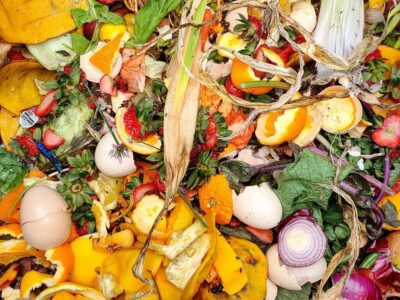
My new Sunday ritual is bringing my food waste for the week to the Columbia University Greenmarket for composting—this has enabled me to cut my garbage volume almost in half. Since I eat lots of fruits and vegetables, all those food scraps always struck me as an incredible waste of a potential resource, so I was very pleased when the Greenmarket began to collect them. Food waste is now collected at 25 GrowNYC Greenmarket locations and many other sites in New York City for composting. It is being turned into black gold—so called because compost, the mixture of decayed organic matter, is valuable as a nutrient-rich soil additive. In the United States, however, less than 3 percent of food waste is composted.
According to a new study by the Natural Resources Defense Council, getting food from the farm to our plates uses 10 percent of the U.S. energy budget, 50 percent of the nation’s land, and 80 percent of all the freshwater consumed in the U.S. Yet, 40 percent of this food is discarded (a whopping 20 pounds plus per person each month), 97 percent of which ends up in landfills; this makes “food waste the single largest component of municipal solid waste reaching landfills and incinerators” according to the U.S. Environmental Protection Agency. This is a huge waste of money for households and for cities and towns that must pay disposal fees. What’s more, it exacerbates global warming because when food buried in a landfill decomposes without exposure to air (anaerobic digestion), it produces methane, a greenhouse gas 21 times more potent than carbon dioxide. A United Kingdom report found that if food waste were removed from its landfills, the reduction in greenhouse gas emissions would be equivalent to removing one-fifth of all the cars on U.K. roads.
Viewing food waste as a renewable resource and the basis of a valuable asset instead of as garbage makes good sense, because nutrient-rich compost has many environmental benefits.

Compost is used in organic agriculture as well as in conventional agriculture for growing berries and vegetables, and in vineyards and orchards. Compost can increase the water retention of soil, improve drought tolerance, provide humus, prevent the growth of weeds, boost crop yields and reduce the need for fertilizer and chemicals. It is used to help prevent erosion. Moreover, compost can revitalize damaged habitats when added to the soil, remediate soils contaminated by hazardous wastes, absorb odors, remove grease and heavy metals from stormwater runoff and destroy volatile organic compounds in contaminated air. And keeping food waste out of landfills avoids the production of methane and toxic leachate (formed when rainwater seeps through landfills and picks up additional water from the decomposition process and chemicals from the waste), which can contaminate groundwater, lakes and streams.
GrowNYC’s Greenmarkets accept food waste including produce scraps, non-greasy foods like carbohydrates, coffee grounds and filters, tea bags, egg and nut shells, pits, flowers, houseplants and potting soil. They do not take meat, fish or dairy products, fat or oil, animal waste, litter or bedding, coal, charcoal, coconuts, diseased or insect-infested plants or biodegradable plastics.
Organic materials allowed to decompose with an adequate amount of oxygen (aerobic digestion) go through three phases as they become compost. In the first moderate-temperature phase, which takes about 2 days, mesophilic microorganisms (organisms that grow best in moderate temperatures) break down the soluble and easily degradable materials as the temperature rapidly rises. When the temperature of the pile rises above 104˚ F, thermophilic (heat-loving) microorganisms take over, and proteins, fats, and complex carbohydrates are broken down—this phase can take from a few days to a few months. Many microorganisms that cause disease in humans or plants are destroyed once temperatures rise about 131˚ F, but temperatures over 149˚ F can kill other helpful microorganisms and slow decomposition, so composters usually keep temperatures below this point by mixing and aerating the pile. Eventually the compost temperature decreases and mesophilic microorganisms return for the curing or maturation process, which takes several months.

Microorganisms such as bacteria, protozoa and fungi do most of the chemical decomposing work, while larger organisms like worms, mites, snails, beetles, centipedes, and millipedes do more of the physical breaking down. Finished compost contains micronutrients like iron, manganese, copper and zinc that plants need to grow well; as well as small amounts of macronutrients like nitrogen, phosphorus, potassium, calcium and magnesium.
In New York City, food waste comprises almost 18 percent of residential waste—650,000 tons a year. The New York City Department of Sanitation collects food waste through the NYC Compost Project Local Organics Recovery Program and the DSNY and GrowNYC Food Scrap Compost Program.
In addition, there are hundreds of community compost sites that have been supported by the NYC Compost Project since 1993. The Department of Sanitation offers its compost to city agencies and nonprofits for use in gardening, soil mitigation, or habitat improvement projects.
GrowNYC, a non-profit that promotes environmental programs, began its compost program in 2011 as a pilot with 7 locations. In April 2012, the GrowNYC/DSNY Greenmarket Food Scrap Compost Program was launched. Since the GrowNYC program’s inception, 792,638 pounds of food scraps have been diverted from the waste stream for composting.

Every month or so, 3 to 4 tons of food waste from its markets is rotated between several community compost sites throughout NYC.
Here are a few examples of where and how aerobic composting is being done in New York City.
The Gowanus Canal Conservancy turns 7,000 to 8,000 lbs. of food waste each month into a “compost lasagna” made of alternating food scrap and “browns” (wood chips, leaves) layers. The layering ensures the right balance of carbon (browns) and nitrogen (food waste) so that the final product is nourishing for plants. The “lasagna” is made into windrows, rows of material that are allowed to sit and decompose. Once cured, the compost is sifted by hand, then distributed to gardens and used to restore habitat next to the polluted watershed.

At Red Hook Community Farm, Added Value, a nonprofit promoting Red Hook’s sustainable development, manages the largest and most diverse community composting project in Brooklyn. It can process up to 160 tons of organic waste a year with a hand-made composting system of winterized wormbins, hand-cranked tumblers and windrows maintained through the winter. The compost is used on the farm, and supplies CSAs (community supported agriculture) and restaurants in the Red Hook area.
The Lower East Side Ecology Center has collected food waste at the Union Square Greenmarket since 1994. Food waste is also collected at the Lower East Side Center Community Garden. The center uses an in-vessel composting system in which food waste is layered with sawdust in large sealed plastic containers. Air passes through vents at the top and bottom of the containers to facilitate decomposition. The material is then cured in windrows with the aid of red wiggler worms. After it’s sifted, the compost is sold at the market as compost or potting soil.

The Western Queens Compost Initiative gets food waste from soup kitchens, CSAs, bike tours, households and greenmarkets. One of its sites utilizes an aerated static pile technique. In aerated static pile composting, organic waste, including material like wood chips to add bulk, is mixed together in a pile instead of in rows. The piles are aerated by a system of pipes under the pile and covered to control moisture and odors. The Western Queens Compost Initiative compost is used for urban agriculture.
Earth Matter NY runs a Compost Learning Center on Governor’s Island in the summer and offers composting advice and assistance. In addition to accepting food waste from GrowNYC’s greenmarkets, it also collects food waste in Bushwick and Fort Greene, Brooklyn.
In the future, demand for local compost may increase because rising fuel prices will make fertilizer more expensive, more frequent droughts may require compost to help water retention, and the spread of organic agriculture could boost demand for compost. More and more community sites and organizations are composting…would it be feasible for New York City to compost food waste on a large scale?
Professor Nickolas Themelis, Director of the Earth Institute’s Earth Engineering Center of Columbia University, noted that Toronto is one big city that successfully composts its food waste. “For New York City, the biggest problem would be collecting the food waste—the collection system would be the most expensive part of the system. But we could start with collecting food waste from restaurants and institutions. Then it could be taken to a place for composting where the city is already collecting park waste, since it would need to be fluffed up with green waste. This could be a prototype.“ Themelis suggested that aerated static piles with a semi-permeable cover of Gore-tex would be the best system for large-scale aerobic digestion because it would control odors and be the most economical. Anaerobic digestion, usually used for large scale composting, would be much more expensive.
Find out where you can turn your garbage into black gold around the country, in New York State or at GrowNYC’s Greenmarkets. Columbia students can also check out The Rocket, a composter set up by the EcoReps composting committee, Housing and Dining Services and the Office of Environmental Stewardship in the Ruggles Residence Hall basement.




Thks for above materials. It has been very beneficial as far as composting is concerned.But I am looking composting from a different angle. How could waste be turned into kitchen fuel
for cooking and what type of device can be used for collection and proper use without polluting the kitchen environment.
[…] projects. GrowNYC, a non-profit that promotes environmental … … Read this article: Composting—Turning Garbage into Black Gold – State of the Planet ← Easy Tips for Organic Vegetable Gardening – Dog Supplies Plus! Start Your Own […]